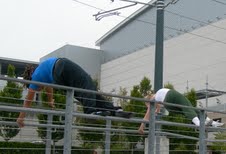Thick is a site-specific performance for Tollefson Plaza created by Tacoma-based choreographer Carla Barragán and Bqdanza dance troupe. This original work, a response to the oil spill tragedy on the Gulf Coast, mourns the environmental disaster while celebrating the grace and beauty of the region’s birds, sea creatures and myriad other habitants. We talked to the Ecuadoran-born choreographer about how an abstract work of art such as a dance piece grows out of a concrete natural (or unnatural, as it were) catastrophe.
Spaceworks Tacoma: I read the proposal you wrote for Thick – it seems heartfelt. How did the piece develop during the ongoing oil spill?
Carla Barragán: A catastrophe of this magnitude affects us all. I experienced feelings of dread as this event unfolded, yet with time I felt more empowered by dealing with it through my choreography…The piece that emerged is a celebration of fauna – in a very abstract manner – the movement has hints of the animals in full life as well as in agony. The dance itself is not a narrative of or political discourse about the oil spill.

ST: Do you have a connection with the Gulf Coast?
CB: We all have a connection with the area. The waterways and oceans of the world are all interconnected. Systems are not mutually exclusive. Therefore, if one system hurts, all systems are compromised, especially the balance of the ecosystems in the long term.
ST: How do you think art and artists can help open people’s eyes to the natural world?
CB: My choreography is not literal and it is usually multilayered. I never try to teach through my work. I use themes that move me…but not to convince audiences of anything except to be open to art. [An audience can be moved by] the dancers’ truthfulness while they perform. I take the dancers through genuine experiences through which they will be connected to the work; I rarely just give them “the steps.” I give them a problem to solve and/or a situation that they can engage in emotionally. The result is an authentic performance that tends to stir the viewers’ emotions. If the resulting art is strong enough to open people’s eyes to the topic of the dance, that is fantastic. Humans have a way of coping with problems that come to them, by simply forgetting as quickly as possible. Art can be a reminder if it touches the right chords.
 Another way artists help open people’s eyes is by doing their work, even work that is abstract, and talking about it, like us right now. That is the way conceptual work gets the attention it does, by the verbiage that supports it. It is not my mode of working, but at least in my work, Thick, it might help people know, understand and mourn the environment by watching something inspired by this disaster.
Another way artists help open people’s eyes is by doing their work, even work that is abstract, and talking about it, like us right now. That is the way conceptual work gets the attention it does, by the verbiage that supports it. It is not my mode of working, but at least in my work, Thick, it might help people know, understand and mourn the environment by watching something inspired by this disaster.
ST: Can you tell me about the soundscapes involved in Thick?
CB: I have selected nature and bird sounds that come from a variety of sources. By random circumstances, I ran into my old time collaborator and friend Luke Smiraldo who told me about his poem “Internal: Reflection on the Gulf Spill as the Hemorrhage Continues,” and we both decided it was perfect to include in the soundtrack for Thick. Despite the traffic [on Pacific Ave.] governing the sound environment, audience members may pick up some parts of the poem and of wilderness sounds while passing by.
ST: You write in your performance proposal that Thick isn’t a literal retelling of the oil spill incident. How does this non-traditional narrative mesh with contemporary movement and music?
CB: As I started explaining earlier, my hope is to give each artist/dancer participating in the project an opportunity to search out a connection with the marine ecosystem and honor the animals affected by the disaster. They engage their imagination with these images of birds and other marine animals that they research themselves, and they reproduce kinesthetic expressions. They will not be mimicking the animals, but some resonance of the animals’ behavior may be caught in the movement. At the same time, the movement will be affected by the structures in the plaza which the dancers will be performing on and around.

ST: Please tell me a little about your Ecuadoran background.
CB: I was born in Quito, Ecuador, to a talented family of contemporary artists. I left at 16 but have gone back several times to live, teach and/or visit, and I still feel extremely passionate about Ecuador. I breathe the culture into my work….I have also lived in New York for 10 years, in Palo Alto, Seattle, and in Mexico. I love Tacoma! I teach theater at a unique elementary school in Spanaway, called Elk Plain School of Choice. It offers all the arts and sciences to kids and I love seeing how art transforms people of that age.
Thick, Tollefson Plaza, S. 17th & Pacific Ave., Sept. 16, 2010. Performances (15-20 min.) at 5:30pm and 7:30pm. Free.
0 thoughts on “Dancing Amidst Catastrophe”